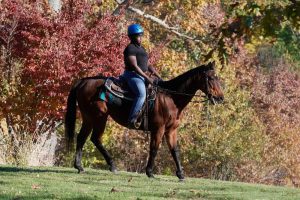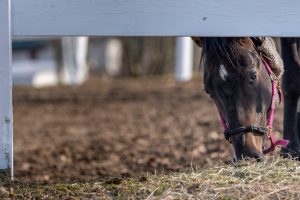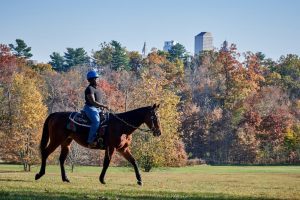Horse Management and the Land in the Fall
Author: Jenifer Nadeau, M.S., Ph.D
Jenifer.Nadeau@uconn.edu
Reviewers: Debra Hagstrom, Extension Specialist, Illinois Extension
Publication # EXT068 | June 2024
 Fall can often be a busy season as temperatures drop, trees change colors and leaves fall and crisp, cool air often leads to more time outdoors. It’s also a great time for land, home and horse owners to consider dealing with not only leaves, but drainage issues, acorns, and storm preparedness. It is a great time to take a look around and assess the horse-keeping situation and be sure that acorns, leaves and drainage don’t cause issues. It is also a great time to get ready to deal with whatever Mother Nature may bring in the time and seasons to come.
Fall can often be a busy season as temperatures drop, trees change colors and leaves fall and crisp, cool air often leads to more time outdoors. It’s also a great time for land, home and horse owners to consider dealing with not only leaves, but drainage issues, acorns, and storm preparedness. It is a great time to take a look around and assess the horse-keeping situation and be sure that acorns, leaves and drainage don’t cause issues. It is also a great time to get ready to deal with whatever Mother Nature may bring in the time and seasons to come.
Red Maple Poisoning
In the fall, as leaves are accumulating on the ground, one worry that many horse owners may have is their horse will consuming wilted or dried red maple leaves, resulting in what is known as ‘red maple disease’ or ‘red maple poisoning’. But the first thing that should be done is to ensure that the maple trees are actually Acer rubrum or red maple, also known as swamp or soft maple.
If the tree truly is a red maple:
- Remove fallen branches and leaves as they fall or keep horses out of pastures when fresh wilted or dried wilted leaves are present
- Consider cutting down all red maple trees and also removing the stumps so that red maple leaves are not an issue. Be vigilant for any suckers that may spring up from the area.

As little as 1.5 -3 grams per 2.2 pounds of body weight of consumption of wilted or dried red maple leaves can become an issue for a horse, causing acute hemolytic anemia (breakdown of oxygen carrying red blood cells), red-tinged urine (due to hemoglobin being passed out), lethargy, and depression. An affected horse will need to be treated with activated charcoal to absorb the toxin as soon as the problem occurs. Once damage has begun, horses will need IV fluid therapy to flush and maintain the function of the kidneys, steroids, and possibly blood transfusions and oxygen therapy.
Drainage
Drainage issues can also be a problem around the horse barn. While taking note of the property throughout the seasons, fall is a good time to ensure that all of the property is well-draining. This limits puddles, which during colder weather can turn into ice. Also be sure to clear gutters of leaves to prevent ice from forming in gutters later, leading to potential breakage and perhaps ice dams. It will also prevent habitat for flies and mosquitoes to breed. Two solutions are to regrade any areas with poor drainage, and perhaps have a drain installed to deal with the issue.
Acorns Toxicity
Although cattle are much more sensitive to acorn toxicity than horses, acorns can also cause toxicity in horses, when consumed in a high amount so it is good to make sure that horses are not consuming acorns. The horse might be seen ingesting the acorns, or acorn remnants may be found in the feed. Acorn toxicity can result in constipation, going off feed, colic, blood-tinged urine, dehydration, and swelling in the legs. If a horse develops these problems, a course of activated charcoal initially and then perhaps IV fluid therapy could be needed.
Additionally, for alleviate acorn issues:
- Fence off oak trees or remove them;
- Clear fallen branches after a storm;
- Keep horses away from fallen oak branches and acorns.

Storm Preparedness
Fall rains often can cause problems and steps include be prepared for power outages, snowstorms, to reconsider fire safety, and take steps to prevent flooding. Storm preparedness also included stocking up on extra feed and water and have a disaster kit ready.
The University of Connecticut supports all state and federal laws that promote equal opportunity and prohibit discrimination.
Additional Resources
Red Maple Leaf Poisoning of Horses. http://www.omafra.gov.on.ca/english/livestock/horses/facts/06-109.htm
Burrows GE, Tyrl RJ. Toxic Plants of North America.Iowa State University Press, 2001.
Consult and follow pesticide labels for registered uses. To avoid potential phytotoxicity problems, spot test before widespread use. No discrimination is intended for any products not listed
The information in this document is for educational purposes only. The recommendations contained are based on the best available knowledge at the time of publication. Any reference to commercial products, trade or brand names is for information only, and no endorsement or approval is intended. UConn Extension does not guarantee or warrant the standard of any product referenced or imply approval of the product to the exclusion of others which also may be available. The University of Connecticut, UConn Extension, College of Agriculture, Health and Natural Resources is an equal opportunity program provider and employer.